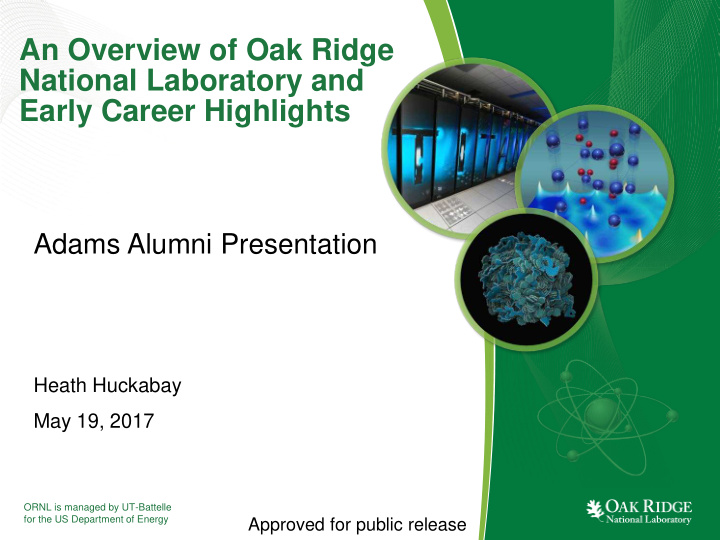



An Overview of Oak Ridge National Laboratory and Early Career Highlights Adams Alumni Presentation Heath Huckabay May 19, 2017 ORNL is managed by UT-Battelle for the US Department of Energy Approved for public release
History of Oak Ridge National Laboratory • Established in 1943 as part of the Manhattan Project – Coded as X-10 – Nearby facilities were Y-12 (calutrons) and K-25 (gaseous diffusion) • Demonstrated the production and separation of plutonium for weapons development Chemical processing techniques were developed The Clinton Pile was the world’s first to separate plutonium from irradiated fuel continuously operated nuclear reactor 2 Presentation_name
Oak Ridge National Laboratory • ORNL is the Department of Energy’s largest science and energy laboratory – 4,559 staff members – 3,200 visiting scientists and users, per year • Major R&D activities include – Neutron science – High performance computing – Materials research for energy applications – Nuclear power research – Biological, environmental, and earth sciences – National security 3 Presentation_name
ORNL Highlights • Neutron Sciences – High Flux Isotope Reactor (HFIR) • 85 MW research reactor – Target irradiation – Spallation Neutron Source • Most intense pulsed neutron source on earth HFIR Core Refueling, 2015 Berkelium-249 Sample • High-Performance Computing – Titan (in use) • Cray • 20+ petaflops (peaks at ~27 PFLOPS) – 20,000+ trillion calculations/second – Summit (in construction) Spallation Neutron Source Mercury Target Used in SNS • IBM Center for Nanophase Materials Science • Estimated performance: 150-300 petaflops • Expected to go online in 2018 • Center for Nanophase Materials Science – Vast array of fabrication and analysis tools • User facilities are free to use, assuming you plan to publish 4 Presentation_name
Research Project Highlights Magnetic Resonance Force Microscopy for Small Scale Spectroscopy Red Oil Identification, Production Conditions, and Mitigation Strategies Brightfield Channel Fluorescence Channel Technology Development for Cotton Radiation Detection Using Stimulated Emission Swipe Screening 5 Presentation_name
National Laboratories vs. Academia • All time is charged to an account – Overhead = • Funding sources – Verboten • National Institutes of Health • Most of NSF – Funding through other agencies are available to national laboratories • Differs between science and weapons labs • Application cycle quite different • Research culture differences – Academia • Faculty advisor serves as PI • Directs efforts of students/postdocs – National Laboratories • Group leaders not directly responsible for funding • Researchers must work with peers to achieve project goals – Multidisciplinary collaboration is necessary for our work 6 Presentation_name
Obligatory Accomplishments Slide • Postdoctoral status from 2012-2014 – Nuclear forensics focused postdoctoral position – Sponsored by the Department of Homeland Security • Hired as permanent staff in 2014 • Involved in ~18 separate projects since 2012 • Roughly 2.5M in funding garnered since FY 2014 – National Nuclear Security Administration • University collaborations included! – Internal ORNL funding mechanisms • Always looking for the next project… 7 Presentation_name
Recommend
More recommend